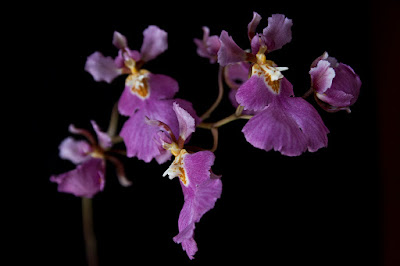Tolumnia pulchella is native to Jamaica. These plants occurs in Brown's Town and surrounding area, in Manchester in the Cockpit Country and in the hills near Mandeville. They grow there on small trees in moderately moist forests, at heights of 300-800 m...
Tolumnia pulchella also called as The Beautiful Tolumnia, Oncidium pulchellum, Oncidium jamaicense, Oncidium sanctae-anae, Oncidium withneranum, Oncidium hartii, Oncidium concavum, Oncidium pulchellum f. concavum, Oncidium pulchellum f. hartii, Oncidium pulchellum f. jamaicense, Oncidium pulchellum f. sanctae-anae, Oncidium pulchellum f. withneranum, Oncidium pulchellum subsp. concavum, Tolumnia concava, is a species of the genus Tolumnia. This species was described by Constantine Samuel Rafinesque in 1836.
IDENTIFY TOLUMNIA PULCHELLA
Tolumnia pulchella is native to Jamaica. These plants occurs in Brown's Town and surrounding area, in Manchester in the Cockpit Country and in the hills near Mandeville. They grow there on small trees in moderately moist forests, at heights of 300-800 m, in full sun and with strong air movement.
It is a miniature, fan shaped, warm to cool growing epiphyte, which reaching 19.3 cm in height, with very short, erect, 1.3 cm long stems enveloped by imbricate, distichous, fleshy to coriaceous, bilaterally flattened, channeled on the upper side, lanceolate, falcate, acute, up to 18 cm long and 2 cm wide leaves.
The Beautiful Tolumnia has a wiry, erect to arcuate, to 50 cm long, paniculate, terete inflorescence that has lanceolate, acuminate bracts with 20, showy flowers occurring in the spring and summer. The flowers are 2.5-3.3 cm measured by the decomposed lip and 3.0-3.9 cm long when measured from the apex of the dorsolateral apex to the tip of the lip. The color of flowers is extremely variable, ranging from white to dark lavender-pink through many shades of pale lavender, pink and purple. Most of the flowers are one-colored, but some have darker veins, and some dark-colored flowers have white edges. At the base of the petals, the inner coat is a brown strand, sometimes small brown spots. The upper sepals and petals are shaped like a spoon, their edges slightly wavy. Lateral sepals of slightly smaller size, connected to each other almost along the entire length and hidden by the lip. The lip is large, widely spread, consists of four round blades of almost the same size. Between the lateral lobes is a crest with reddish-brown strips and a dark-yellow or brown spot.
TOLUMNIA PULCHELLA CARE AND CULTURE
Cultural information should only be used as a guide, and should be to be adapted to suit you. Your physical location; where you grow your plants, how much time you have to devote to their care, and many other factors, will need to be taken into account. Only then can you decide on the cultural methods that best suit you and your plants.
Light:
Tolumnia pulchella needs a light level of 25000-35000 lux. These plants require bright, slightly filtered or scattered light and protection against direct effects of the midday sun. Strong air movement should be ensured all the time.
Temperature:
The average temperature of the summer day is 28-29 ° C, night 21 ° C, and the daily difference is 7-8 ° C. The average temperature of the winter day is 26 ° C, the night 18-19 ° C, and the daily difference is 7-8 ° C.
Humidity:
The Beautiful Tolumnia needs the humidity of probably 70-75% throughout the year.
Substrate, growing media and repotting:
Tolumnia pulchella grow best in small, empty clay pots without a substrate. They are also grow well attached to pieces of cork, wood or twigs. Such cultivation requires, however, maintaining high humidity in the summer of daily watering, and in the case of hot weather even several times. It is also possible to grow in small pots filled with a loose, permeable substrate that allows the roots to dry quickly after watering.
They should be repotted or divided as rarely as possible, because they react adversely to violating the root ball. Necessary repotting or dividing plants should be done when the growth of new roots begins. This allows the plants to acclimatize in a relatively short time and provides them with the least stress.
Watering:
Precipitation is small to moderate throughout the year, only at the end of winter and at the beginning of spring is a little drier. The cultivated plants should be watered or sprayed regularly during the growing season, but after watering the roots must dry quickly, and the plants between the waterings must always dry out.
Fertilizer:
Weekly application of 1/4-1/2 of the recommended dose of orchid fertilizer during the active growth is recommended. From spring to mid-summer, high-nitrogen fertilizer should be used, and then until the end of autumn high-phosphoric fertilizer.
Rest period:
Tolumnia pulchella in the winter need less water, but they can not be without it for too long. Light fogging on sunny days is beneficial. Fertilization should be reduced or eliminated until spring, when more watering is undertaken.















COMMENTS